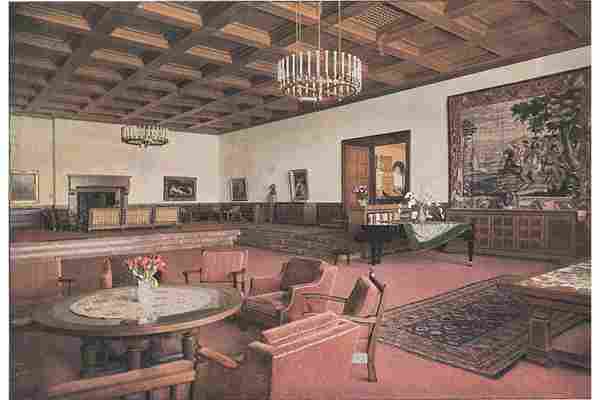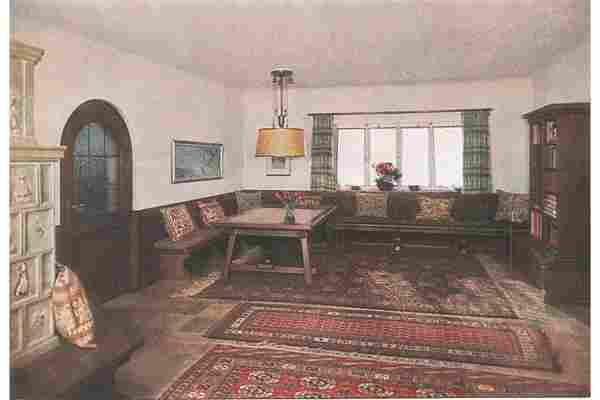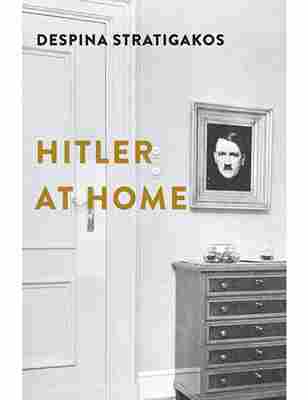October 14,2022
The Decorator and the Monster
by David Stewart
Books about interior design often seduce but they rarely rattle. Hitler at Home (Yale University Press, $40), inarguably the powder-keg title of the year, accomplishes both in equal measure. Consider the cover photograph, snapped by Eva Braun, the führer’s longtime mistress, and recording a detail of the chalet they secretly shared in the Bavarian Alps. Bordered by an aristocratic doorframe and herringbone parquet stands a highly polished chest of drawers that suavely echoes 18th-century neoclassicism; above it hangs a portrait of the man of the house framed in dramatically stepped gilt-wood, his disembodied head floating against a dark field like the great and powerful Oz. That image, actually an election poster, viscerally repels, but the space around it is suggestively cozy, evidence of how a foreign rabble-rouser had transformed himself into his adopted nation’s paterfamilias—which was precisely the intention of interior decorator Gerdy Troost (1904–2003) and her architect husband, Paul (1878–1934).
“The goal of the book was not to humanize Hitler but to show how he was humanized,” explains author Despina Stratigakos, the interim chair of the University of Buffalo’s department of architecture, where she is an associate professor. “In the 1930s he had this image of cultivation and taste, but just a decade earlier he was considered deeply unappealing,” she says. “How did he manage to re-create himself?” Seeking the answer was not taken lightly: Stratigakos’s mother spent part of her childhood in occupied Greece and warned her daughter not to be seduced by Nazi aesthetics, saying, “Please do not make Hitler look good.”

A circa-1936 postcard view of Berghof’s Great Hall, a reception room created by architect Alois Degano and decorator Gerdy Troost.
To many Germans, though, Hitler was appealing, and the author of Hitler at Home admits that Nazi propaganda was so effective that it was a juggling act for her “to present the material without re-creating its power.” The throngs saluting the führer at immense political rallies, staged against the overpowering neoclassical buildings designed by architect Albert Speer, captivated a nationalistic segment of the population still aggrieved by the country’s humiliating defeat in World War I and its subsequent financial collapse. But domestic-sphere photo ops—a dining table set with custom-made Nymphenburg china and gleaming silver, a welcoming salon paneled with native German walnut and furnished with comfortable armchairs, Hitler signing an autograph for a child on his terrace or feeding deer in the countryside—added to the dictator’s fan base by casting him, Stratigakos says, as “a figure of empathy, a man living in settings that many readers could relate to. Hitler’s homes were not blank or bland spaces but part of an ingenious public-relations campaign.” She continues, “Almost without realizing it, you start projecting fantasies onto the photographs, imagining how you might drop in and have tea with him. The aesthetic was on display, but the horror was clinging to the other side.”
The world’s most important newspapers and fashionable magazines, Vogue and British Homes & Gardens among them, published images of Hitler’s residences, most prominently his 15-room apartment on Munich’s Prince Regent Square and the sprawling chalet known as Berghof, or Mountain Farm. As embodiments of what Hitler at Home calls the “projected desires for the good life promised to the German people by the Nazi Party,” both were beautifully remodeled and redecorated by Atelier Troost, whose sophisticated yet understudied oeuvre stunned Stratigakos. “Our image of the Third Reich’s style is so influenced by Albert Speer’s rigid neoclassicism and its disproportions, but I came to find that Gerdy’s work was really in line with modern trends elsewhere in the world, moving away from Bauhaus coldness and toward luxurious materials, rich fabrics, textures, and sensuality.”
The New York Times Magazine explored the ever-expanding Berghof in 1937, hailing it as a timber cottage turned “modernistic mansion . . . with spacious halls and many rooms sumptuously furnished . . . and [with] a gorgeous display of bright flowers in the window boxes.” One of the Bavarian Revival structure’s most talked-about features was the Great Hall’s vast picture window (Hitler’s idea, though Gerdy Troost fought in vain against its spatial bombast), which could be lowered into the floor to take in a cinematic view of the Alps, with Salzburg, Austria, in the distance. Former British prime minister David Lloyd George visited Berghof in 1936 and was so impressed by the window that, once back home, he asked architect Sir Owen Williams to punch a similar one through a wall at Bron-y-de, his country place in Surrey.

In the mid-1930s, Gerdy Troost revamped Hitler’s living room at Berghof with a contemporary take on the Alpine vernacular.
Fascinated by the political messages that infuse built environments, Stratigakos stumbled across the Troosts during an archival trawl in Berlin in the 1990s. “I was trying to find a dissertation topic and wanted to work on women active in the early 20th century,” she explains. “I heard Gerdy’s name, though I didn’t really know anything about her other than she was active during the Third Reich, and submitted a request for any papers relating to her. Lo and behold, the archivist came out with a trolley stacked with files. My jaw dropped; that was my first clue that something was different. I start flipping through furniture sketches, architectural plans, and invoices for velvet to be used for Hitler’s curtains and then came across letters pleading for help from a whole gamut of people in misery during the war. Why were they writing to Troost?”
Stratigakos soon learned that Troost, who continued to work for private clients into the 1970s, was initially skeptical of Hitler, whom her husband had chatted with at a Munich society party in 1930 and insisted that she meet. Six days later she did, quickly becoming a fast friend of the head of the National Socialist German Workers’ Party and eventual führer. He “behaves like a truly splendid, serious, cultivated, modest chap,” the decorator wrote to her mother, adding that, given his crass and aggressive public persona, she was surprised by his sensitivity to art and architecture. “Gerdy was somewhat apolitical but that didn’t last very long before she went in for Hitler 110 percent,” Stratigakos says, noting that although the decorator successfully intervened on behalf of Jewish friends and associates who were threatened by the Nazi regime, she “never felt the need to put two and two together. Gerdy believed Hitler was going to create a cultural revival that would bring back German greatness. Even in her last years, she never turned her back on him.”

Hitler at Home was released this fall by Yale University Press.
As for the buildings, interiors, and furnishings that the Troosts conjured up as two of National Socialism’s most trusted tastemakers, Stratigakos—who is now researching Norway’s plethora of Nazi-era buildings, more than were constructed in any other occupied country—is a conflicted admirer. “Much of this stuff is in museum collections, but you wouldn’t know it because it is so rarely exhibited. If you put it out there, it would elicit admiration on an aesthetic level,” she says. But, the scholar adds, “do you want that?”






